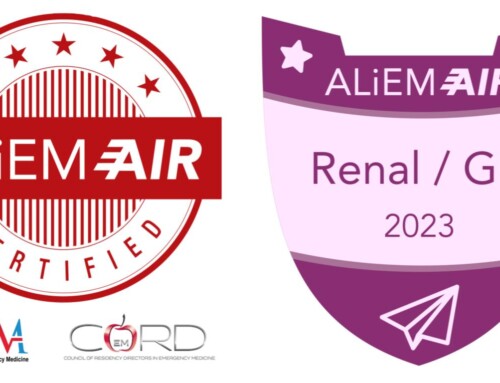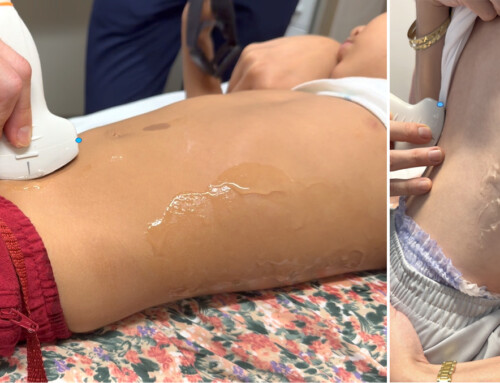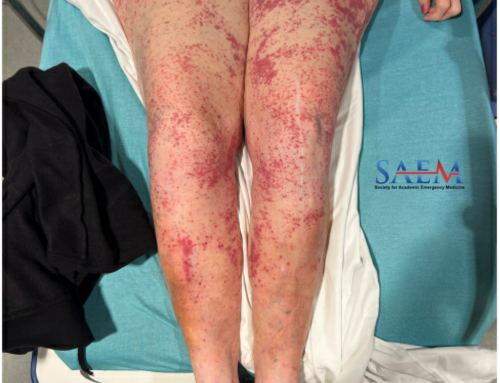
Production and use of free open access medical education resources (FOAM) has had a meteoric rise over the last decade.1–4 ALiEM works hard to produce content, disseminate knowledge, and consolidate resources in a democratic and accessible way. However, we recognize that FOAM comes with its own limitations:
- Blogs are distinct, individual, and decentralized. How can we search for topic-specific content?
- FOAM doesn’t often have peer review. How can we assess quality and accuracy?
- FOAM is produced on an as-needed basis. How do we achieve curricular comprehensiveness?
We recently published a project in Academic Emergency Medicine Education and Training that tries to address the above limitations, using the renal and genitourinary organ system as a “focus group”.5
Limitation 1: Distinct, individual, and decentralized blogs. How can we search for topic-specific content?
We developed search terms specific to the renal and genitourinary organ system from the American Board of Emergency Medicine’s Model of the Clinical Practice of Emergency Medicine. We then performed a systematic search of both FOAMSearch as well as each site within the social media index top 100.6,7Unlike the AIR series, which collects content published within the last 12 months, our search included any relevant resources regardless of publication date.8
Limitation 2: No peer review. How can we assess quality and accuracy?
Of the 13,058 resources identified, 12,717 were found to be journal articles, duplicates, not relevant to emergency medicine or renal, or not FOAM. These were excluded. The 341 remaining articles underwent quality assessment using the revised METRIQ score and were categorized based on subtopic within renal and genitourinary, recommended use of the resource, and recommended learner level for the resource.9
Calculus of the urinary tract (17.6% of total) led the subtopics with more than twice as many FOAM posts as the next topic, acute and chronic renal failure (7.6%). Most commonly, posts were appropriate for personalized reading followed by post-shift reading assignment. Few posts were appropriate for on-shift learning or as an adjunct to a journal club. Lastly, junior residents were found to be an appropriate audience most often (76.3%), followed by interns (64.2%), senior residents (56.4%), clerks (i.e., third- or fourth-year medical students, 52.1%), attendings (40%), and pre-clerks (i.e., first- or second-year medical students, 29.0%).
Interestingly, only 35 posts met our criteria for high quality. This table below can serve as a curated, categorized centralized list of renal and genitourinary FOAM resources.
| Subtopic | Name of First Author | Name of Blog Post | Level of Trainee |
| Calculus of urinary tract (renal colic) | Helman, Anton | Journal Jam 3 – Ultrasound vs CT for Renal Colic | Junior, Senior, Attending |
| Calculus of urinary tract (renal colic) | Chartier, Lucas | Episode 5: Renal Colic, Toxicology Update & Body Packers | Clerk, Intern, Junior, Senior, Attending |
| Calculus of urinary tract (renal colic) | Swaminathan, Anand | Optimal First Line Analgesia in Ureteric Colic | Intern, Junior, Senior, Attending |
| Topic not on list (foley catheter problems) | Schneider, Aaron | Foley Catheter Patients: Common ED Presentations / Management / Pearls & Pitfalls | Intern, Junior, Senior |
| Calculus of urinary tract (renal colic) | Firestone, Daniel | Top 10 reasons NOT to order a CT scan for suspected renal colic | Intern, Junior, Senior, Attending |
| Cystitis | Sahsi, Rupinder | Diagnosing Pediatric Urinary Tract Infections | Clerk, Intern, Junior, Senior, Attending |
| Hemolytic uremic syndrome | Swartz, Jordan | Hemolytic Uremic Syndrome (HUS) | Intern, Junior, Senior |
| Urinary retention | Benitez, Javier | First ALiEM journal article: Trial of void for acute urinary retention | Clerk, Intern, Junior, Senior, Attending |
| Calculus of urinary tract (renal colic) | Shih, Jeffrey | Ultrasound For The Win: 46F with Right Abdominal and Flank Pain #US4TW | Clerk, Intern, Junior, Senior |
| Calculus of urinary tract (renal colic) | Swaminathan, Anand | Medical Expulsion Therapy with Tamsulosin in Ureteral Colic | Junior, Senior, Attending |
| Calculus of urinary tract (renal colic) | Swaminathan, Anand | Medical Expulsion Therapy in Ureteral Colic: An Update | Junior, Senior, Attending |
| Calculus of urinary tract (renal colic) | Swaminathan, Anand | Medical Expulsive Therapy (MET) in Renal Colic | Junior, Senior, Attending |
| Calculus of urinary tract (renal colic) | Chitnis, Subhanir | Nephrolithiasis: Diagnosis and Management in the ED | Junior, Senior, Attending |
| Pyelonephritis | Nickson, Chris | Urosepsis | Clerk, Intern, Junior |
| Dysuria | Lin, Michelle | Paucis Verbis card: Urinary tract infection | Intern, Junior, Senior |
| Cystitis | Shenvi, Christina | Uncomplicated Urinary Tract Infection in Older Adults: Diagnosis and Treatment (Part 1) | Preclerk, Clerk, Intern, Junior, Senior |
| Cystitis | Shenvi, Christina | Uncomplicated Urinary Tract Infections in Older Adults: Diagnosis and Treatment (Part 2) | Preclerk, Clerk, Intern, Junior, Senior, Attending |
| Acute and chronic renal failure | Hayes, Bryan | Piperacillin/Tazobactam and Risk of Acute Kidney Injury with Vancomycin | Junior, Senior |
| Calculus of urinary tract (renal colic) | LaPietra, Alexis | Intravenous lidocaine for renal colic | Intern, Junior, Senior, Attending |
| Hematuria | Saunders, Fiona | Investigating microscopic haematuria in blunt abdominal trauma | Junior, Senior, Attending |
| Urinary retention | Rezaie, Salim | Urinary Retention: Rapid Drainage or Gradual Drainage to Avoid Complications? | Junior, Senior, Attending |
| Calculus of urinary tract (renal colic) | Milne, Ken | SGEM#202: Lidocaine for Renal Colic? | Intern, Junior, Senior, Attending |
| Calculus of urinary tract (renal colic) | Wightman, Rachel | Ultrasonography vs CT in Renal Colic | Intern, Junior, Senior, Attending |
| Hemolytic uremic syndrome | Long, Brit | EM@3AM – Hemolytic Uremic Syndrome | Junior, Senior, Attending |
| Gangrene of the scrotum (Fournier’s gangrene) | Cohen, Paul | How do we misdiagnose and mismanage necrotizing fasciitis? | Junior, Senior, Attending |
| Gangrene of the scrotum (Fournier’s gangrene) | Santistevan, Amie | Necrotizing Fasciitis: Pearls & Pitfalls | Preclerk, Clerk, Intern, Junior, Senior, Attending |
| Urinary retention | Fox, Sean | Urinary Retention in Kids | Junior |
| Torsion | Shih, Jeffrey | Ultrasound For The Win: 22M with crotal Pain #US4TWS | Junior, Senior, Attending |
| Genital lesions | Lin, Michelle | Paucis Verbis: Genital Ulcers | Clerk, Intern, Junior, Senior |
| Pyelonephritis | Long, Brit | Pyelonephritis: It’s not always so straightforward… | Preclerk, Clerk, Intern, Junior, Senior, Attending |
| Topic not on list | Sparks, Matt | Renal Fellow Network: Top nephrology-related stories of 2016 | Junior, Senior, Attending |
| Epididymitis/Orchitis | Shih, Jeffrey | Ultrasound For The Win! Case – 64M with Fever and Scrotal Pain #US4TW | Intern, Junior, Senior, Attending |
| Calculus of urinary tract (renal colic) | Lin, Michelle | Author Insight: Ultrasonography versus CT for suspected nephrolithiasis | NEJM | Junior, Senior, Attending |
| Calculus of urinary tract (renal colic) | Swaminathan, Anand | Alpha Blockers in Renal Colic: A systematic review | Junior, Senior, Attending |
Limitation 3: FOAM is produced as needed. How do we achieve curricular comprehensiveness?
As you can see in our publication’s table 2 below, numerous topics exist with no-to-limited coverage and even less topic coverage among highly rated posts. This is important to note. For FOAM producers, this can serve as a call to produce less frequently covered topics to fill these curricular holes. For learners, be aware that the following subtopics are less often covered in FOAM and refer to a textbook or other resource to identify gaps in your own content review. For educators seeking to ensure their learners learn comprehensively, this breakdown may serve to help them emphasize different topics in recommended resources or in classroom learning to ensure a well-rounded emergency medicine education.
Table 2: Renal and Genitourinary SOAR Review Subtopic Analysis
References:
Special thanks to SOAR coauthors Theresa Chan, Anuja Bhalerao, Brent Thoma, Annie Wescott, and Seth Trueger.
- Scott K, Hsu C, Johnson N, Mamtani M, Conlon L, DeRoos F. Integration of social media in emergency medicine residency curriculum. Ann Emerg Med. 2014;64(4):396-404. doi:10.1016/j.annemergmed.2014.05.030
- Purdy E, Thoma B, Bednarczyk J, Migneault D, Sherbino J. The use of free online educational resources by Canadian emergency medicine residents and program directors. CJEM. 2015;17(2):101-106. doi:10.1017/cem.2014.73
- Pantaleoni M. [Benedetto Schiassi and peripheral anesthesia]. Minerva Anestesiol. 1967;33(3):196-200. https://www.ncbi.nlm.nih.gov/pubmed/4885578.
- Cadogan M, Thoma B, Chan T, Lin M. Free Open Access Meducation (FOAM): the rise of emergency medicine and critical care blogs and podcasts (2002-2013). Emerg Med J. 2014;31(e1):e76-7. doi:10.1136/emermed-2013-203502
- Grock A, Bhalerao A, Chan T, Thoma B, Wescott A, Trueger N. Systematic Online Academic Resource (SOAR) Review: Renal and Genitourinary. AEM Educ Train. 2019;3(4):375-386. doi:10.1002/aet2.10351
- Raine T, Thoma B, Chan T, Lin M. FOAMSearch.net: A custom search engine for emergency medicine and critical care. Emerg Med Australas. 2015;27(4):363-365. doi:10.1111/1742-6723.12404
- Thoma B, Sanders J, Lin M, Paterson Q, Steeg J, Chan T. The social media index: measuring the impact of emergency medicine and critical care websites. West J Emerg Med. 2015;16(2):242-249. doi:10.5811/westjem.2015.1.24860
- Lin M, Joshi N, Grock A, et al. Approved Instructional Resources Series: A National Initiative to Identify Quality Emergency Medicine Blog and Podcast Content for Resident Education. J Grad Med Educ. 2016;8(2):219-225. doi:10.4300/JGME-D-15-00388.1
- Colmers-Gray I, Krishnan K, Chan T, et al. The Revised METRIQ Score: A Quality Evaluation Tool for Online Educational Resources. AEM Educ Train. 2019;3(4):387-392. doi:10.1002/aet2.10376




